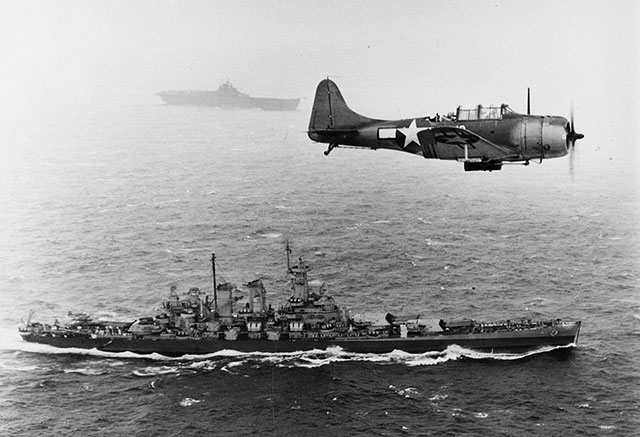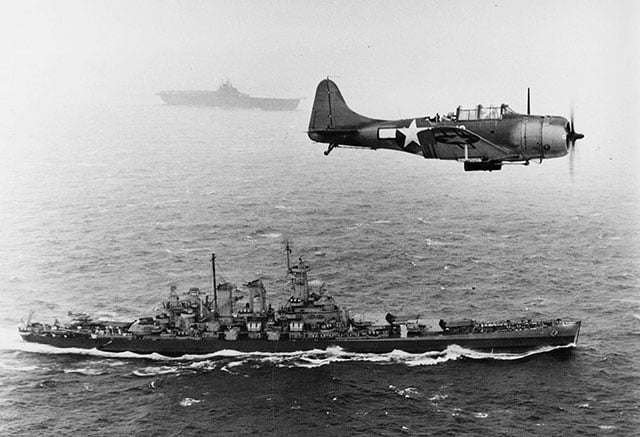
 A US Navy Douglas SBD-5 Dauntless flies an antisubmarine patrol low over the battleship USS Washington en route to the invasion of the Gilbert Islands, November 12, 1943. World War II marked the beginning of the United States’s transformation into the world’s policing power, represented by ongoing overt and clandestine warfare. (Photo: US Navy)
A US Navy Douglas SBD-5 Dauntless flies an antisubmarine patrol low over the battleship USS Washington en route to the invasion of the Gilbert Islands, November 12, 1943. World War II marked the beginning of the United States’s transformation into the world’s policing power, represented by ongoing overt and clandestine warfare. (Photo: US Navy)
The end of World War II marked the beginning of United States military dominance, which only grew after the collapse of the Soviet Union. This period has been characterized by the US becoming the world’s police force, not its peacekeeper. Truthout interviewed John W. Dower, author of The Violent American Century, about this evolution.
Mark Karlin: What was the military posture of the United States before and after World War II?
John W. Dower: There are many points that can be made here. I’d stress three as a starter:
- Before Japan’s attack on Pearl Harbor, isolationist sentiment in the United States was strong. The attack enabled President Franklin D. Roosevelt to declare war on Germany as well as Japan; and the upshot of the war was America’s preeminence as the most prosperous and militarily powerful nation in the world. Maintaining that military preeminence through what later became called “technological asymmetry” and “full spectrum dominance” became gospel in US politics and military planning circles.
- Wartime advances in military technology were phenomenal across the board, and especially conspicuous in the development of air power. This culminated most spectacularly, of course, in the atomic bombs dropped on Hiroshima and Nagasaki by the US Army air force in August 1945. (The Air Force did not become a separate military branch until 1947.)
- Development of these weapons of mass destruction was accompanied by a profound transformation in thinking about conducting “total war” in an age of advanced industrialization. Before Pearl Harbor, US and British leaders had strongly condemned German and Japanese bombing of civilians as being beyond the pale of civilized behavior. By 1942-43, they had reversed course and identified destroying enemy morale as a legitimate target. By war’s end, the saturation bombing of German and Japanese urban populations was standard Anglo-American operating procedure. Prior to dropping the atomic bombs, US air raids already had devastated 64 large and medium-sized Japanese cities.
This US policy of saturation bombing carried over to the Korean War (1950-53) and the massive bombing of Vietnam, Laos and Cambodia between 1965 and 1973. In both of these later wars, the tonnage of bombs dropped by US aircraft greatly exceeded the tonnage dropped on Japan in 1945.
Can you add some more background on why World War II helped catapult the United States into the world’s policeman and made this “the Violent American Century“?
The US, Britain and the Soviet Union were allies against Germany and Japan during World War II. In fact, few Americans or Brits today probably know that the Soviet Union suffered by far the greatest fatalities in World War II. (Wikipedia reasonably puts total military and civilian war dead in the Soviet Union as 26 to 27 million; the estimate for China is 15 to 20 million.) Be that as it may, by war’s end both the US and Britain had come to see the Soviet Union — and “Soviet-led” Communism — as the greatest peril facing the postwar world. This fear was heightened by Stalin’s imposition of control over Eastern European countries the Soviets invaded in the wake of Germany’s collapse (Czechoslovakia, Poland, Hungary, Romania, Bulgaria and East Germany). It was further heightened by the vigor of Communist and left-wing movements in many of the shattered nations of the rest of Europe — and soon thereafter by left-wing movements for national liberation in the former European colonies in Asia and elsewhere in the world.
 John W. Dower. (Photo: Haymarket Books)The origins of the Cold War will always remain a highly contentious subject. It is fair to say, however, that the US haste to drop the two atomic bombs on Japan was in part intended as a warning to the Soviet Union — and the subsequent nuclear arms race reflected US paranoia about Soviet threats and intentions.
John W. Dower. (Photo: Haymarket Books)The origins of the Cold War will always remain a highly contentious subject. It is fair to say, however, that the US haste to drop the two atomic bombs on Japan was in part intended as a warning to the Soviet Union — and the subsequent nuclear arms race reflected US paranoia about Soviet threats and intentions.
The rhetoric of an “American Century” itself comes from an essay by the publisher Henry Luce in the February 1941 issue of Life magazine. Luce’s emphasis here was not on becoming the world’s policemen — indeed, he said this would not be possible — but rather on spreading American democratic values and economic prowess throughout the world. This became the ideological underpinning of the ensuing American Century — and Luce quickly threw himself and his publications (Time, Life and Fortune) behind a militant Cold War agenda, even to the point of privately endorsing preemptive nuclear war against the Soviet Union.
I would emphasize, however, that “The Violent American Century” I chose as title for the book reflects the fact that the United States has been far and away the dominant military and economic power ever since World War II. It has not, however, been all powerful; and the violence that has wracked the world over these many decades is anything but an American monopoly — as the voluminous data on worldwide war-related deaths and other humanitarian tragedies takes care to document.
My focus on violence actually challenges two mainstream arguments in current US scholarship and commentary. One is that global violence of every sort has declined drastically over time, and conspicuously so since World War II. Quantitative data can indeed be marshaled to support this argument — but my focus has been to analyze the enormous violence that still characterized these decades. The second mainstream argument the book challenges is that US overt and covert military operations since World War II have been fundamentally “peacekeeping” and “humanitarian” undertakings. That is a fairy tale.
In what way is torture intertwined with unrestrained war-making?
Torture and atrocity are part and parcel of all wars. In the “war on terror,” Abu Ghraib and CIA “rendition” of prisoners to black sites in other countries where they could be tortured are notorious examples of this on the American side. One can find comparable barbarities in earlier US wars, going back to the decimation of the Amerindians and conquest of the Philippines in 1899-1902. In the book, I devote a short chapter to the “torture texts” the US military’s School of the Americas used in their classes for rightwing military officers from Latin America in the 1980s, which were partly recycled from texts used during the Vietnam War. I also take care, however, to call attention to the far more extensive reliance on torture in countries like the former Soviet Union, People’s Republic of China, North Korea, etc.
More than torture, what interested me in this project is “terror” in the post-World War II world. Thus, the subtitle: “War and Terror since World War II.” In current scholarly and think-tank and journalist circles, terror and terrorism are almost always associated with “non-state actors” — most conspicuously and specifically, of course, Islamist fundamentalists including suicide bombers. By contrast, I am more focused on the legacy of the terror bombing practiced with devastating effect by the United States and Britain in World War II and subsequently extended to Korea and then Indochina. In a complementary but quite different direction, I open the book with an early chapter on “Cold War Nuclear Terror.” Rattling the nukes lies at the very heart of deterrence theory.
How do you react to those who would propose that the US Defense Department is a misnomer, that it is actually the department of aggressive offensive war?
This is a pretty gross simplification of a complex bureaucratic evolution that traces back to 1789, when the US government created a War Department responsible for both army and naval affairs. In 1798, the navy split off as a separate department, and the army continued under the War Department nomenclature right through World War II. The air forces developed under the aegis of the Army until 1947, when it was hived off as a separate department. The significant postwar bureaucratic reorganization of the military took place under the so-called National Security Act of 1947, which created a unified military command under a single Secretary of Defense, and this new military establishment was named the Department of Defense in 1949.
Over the decades that followed, this has evolved into the gargantuan military and “security” establishment we identify today as “the Pentagon” or, in broader and more pejorative (and more accurate) words, the national security state. As of 2015, the Department of Defense was the largest employer in the world with close to 2.9 million employees (1.3 million active-duty military, over 740,000 civilian employees, and over 825,000 National Guard and reservists). Its annual budget is greater than the next eight, nine, or ten major powers combined — and the so-called “base budget” that gets attention when voted on by Congress ($524 billion proposed by the Obama administration for FY 2016) does not include ongoing war costs or veterans benefits and the like, and drastically understates actual annual “defense” expenditures, which come to around $1 trillion a year. The Violent American Century gets into this a bit also.
Maintaining an awesome capability for offensive war is obviously central to the Pentagon mission, and — as we have seen in Indochina and the Middle East — this can be and is used to aggressive ends, whatever the official rhetoric of “defense” or “security” or “peacekeeping” may be. But this Leviathan is vastly more complex in nature, mission, function (and corruption) than just this.
What role did September 11 play in the United States’ military profile?
Obviously, September 11 prompted the Bush administration to plunge us into the quagmire in the Greater Middle East that we see today. Despite its awesome firepower,
however, since World War II the US military has, with but one notable exception, been remarkably unsuccessful when it comes to winning wars. The Korean War ended in stalemate. The “Vietnam War” (actually Vietnam, Laos and Cambodia) was a defeat. And today — 16 years after 9/11 — the United States is embroiled in no less than six conflicts in the Greater Middle East that show no sign of resolution (Iraq, Afghanistan, Syria, Libya, Yemen and Somali) — not to mention covert activities by “special operations forces” in well over 100 countries.
The one conspicuous exception to this record of military failure is the short Gulf War against Saddam Hussein’s Iraq in 1991. In the book, I see this as a major and fascinating turning point in postwar US military activity. The Gulf War coincided with the implosion of the Soviet Union and putative end of the Cold War. It also marked the first actual war fighting deployment of what military insiders for some years had touted as a “revolution in military affairs” — namely, the serious battlefield use of computers and precision (“smart”) weapons. This was a watershed moment in military circles; and the quick and crushing defeat of Iraq’s conventional military forces created a fatal hubris in US military circles that goes far to helping explain the idiotic overconfidence with which the United States rushed into its highly militarized “war on terror” after September 11 — all the while predicting a “cakewalk” and “light footprint’ and quick “in-and-out” operation.
This post-9/11 fiasco, of course, had many often-grotesque faces. For a while the US engaged, with enormous incompetence and corruption, in “nation building.” Around 2006, the Army and Marines rediscovered “counterinsurgency.” “Privatization” of the US military went wild: for most of the 2000s, the number of private contractors working for the United States in Afghanistan and Iraq was equal to the number of US military forces deployed. And all the while, this heavy-handed incompetence simply swelled the ranks of insurgents and anti-American Islamist terrorist organizations.
How do technological weapons enhance the US’s ability to make war and commit staggering violence?
The many defenders of “the revolution in military affairs” in general, and “precision warfare” specifically, argue that smart, computerized weaponry has drastically reduced US battle casualties and, beyond this, greatly reduced “collateral damage.” And it is true that the devastating saturation bombing of the past — as seen in World War II, Korea and Indochina — is no longer standard operating procedure in US air war policy. (One reason for this is that popular revulsion at the televised slaughter of the Vietnam War persuaded US planners that wholesale killing of civilians was counterproductive, but the advent of more accurate weaponry abetted this significant shift in targeting.) The numbers of war-related deaths in Afghanistan and especially Iraq are tragic, but they do not come close to the millions of men, women, and children killed in US air raids in World War II and the Korean and Indochina conflicts.
Much — but by no means all — of the violence we see today in the Greater Middle East has come about as an indirect consequence of US war policy. Much, on the other hand, has indigenous ethnic, religious, tribal and political origins. The violence is indeed staggering — and the tragedy extends beyond war-related deaths to the enormous number (close to 65 million) of refugees and internally displaced persons we see today.
President Obama’s cherished agenda of drone warfare suggests some of the complexity of this. This is obviously an assassination project, but the argument is that by targeting supposedly clearly identified enemy leaders, the numbers killed are far smaller than might otherwise be the case and “collateral damage” has been kept to a minimum. We know, of course, that in fact US drone attacks have killed a considerable number of noncombatants. Tom Engelhardt at the TomDispatch website, for example, has kept a grim tally of some eight wedding parties mistakenly wiped out by US drones. Still, in the big historical picture, the number of individuals thus far killed by drones is not great.
The real challenge posed by this post-Cold War fixation on precision weaponry is that there is no end to it. Sooner or later everyone will have drones (now it is primarily the US, Britain and Israel), and high-tech assassination will be just one more new name of the game. The same holds true for another pet Obama project: “nuclear modernization,” with all the craziness and mind-boggling costs that swirl around this. President Trump, predictably, has pledged to carry this much further.
The problem is not just the almost pathological US fixation on maintaining “technological asymmetry” and “full spectrum dominance,” but the fact that this is both provocative and trend-setting. Adversaries feel compelled to keep pace as best they can. Erstwhile allies want in on the new hardware and software. US weapons producers are overjoyed to sell it, and politicians of states where these manufacturing facilities are situated fall over each other to approve such sales. Once the new weapons are in hand, the desire to try them out “in reality” is almost irresistible.
We’re not backing down in the face of Trump’s threats.
As Donald Trump is inaugurated a second time, independent media organizations are faced with urgent mandates: Tell the truth more loudly than ever before. Do that work even as our standard modes of distribution (such as social media platforms) are being manipulated and curtailed by forces of fascist repression and ruthless capitalism. Do that work even as journalism and journalists face targeted attacks, including from the government itself. And do that work in community, never forgetting that we’re not shouting into a faceless void – we’re reaching out to real people amid a life-threatening political climate.
Our task is formidable, and it requires us to ground ourselves in our principles, remind ourselves of our utility, dig in and commit.
As a dizzying number of corporate news organizations – either through need or greed – rush to implement new ways to further monetize their content, and others acquiesce to Trump’s wishes, now is a time for movement media-makers to double down on community-first models.
At Truthout, we are reaffirming our commitments on this front: We won’t run ads or have a paywall because we believe that everyone should have access to information, and that access should exist without barriers and free of distractions from craven corporate interests. We recognize the implications for democracy when information-seekers click a link only to find the article trapped behind a paywall or buried on a page with dozens of invasive ads. The laws of capitalism dictate an unending increase in monetization, and much of the media simply follows those laws. Truthout and many of our peers are dedicating ourselves to following other paths – a commitment which feels vital in a moment when corporations are evermore overtly embedded in government.
Over 80 percent of Truthout‘s funding comes from small individual donations from our community of readers, and the remaining 20 percent comes from a handful of social justice-oriented foundations. Over a third of our total budget is supported by recurring monthly donors, many of whom give because they want to help us keep Truthout barrier-free for everyone.
You can help by giving today. Whether you can make a small monthly donation or a larger gift, Truthout only works with your support.
